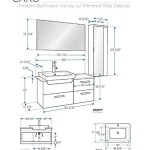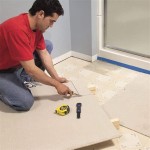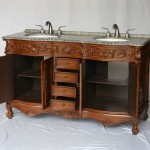Essential Aspects of Wheelchair Accessible Bathroom Vanities
Wheelchair Accessible Bathroom Vanities (noun) are a crucial aspect of accessible bathroom design. They provide individuals with disabilities the independence and comfort they need to perform daily tasks in a safe and dignified manner. Understanding the essential aspects of these vanities is paramount for creating accessible and inclusive bathroom spaces.
Key Considerations
Height and Reach: Vanities should be at a height that allows users to comfortably reach the sink and countertops while seated in their wheelchairs. The standard height for wheelchair-accessible vanities is between 29 to 34 inches, which aligns with the seated position of most wheelchair users. Additionally, the sink should feature an extended reach faucet that provides ample clearance for hands and arms.
Maneuverability: Enough space beneath the vanity is necessary to accommodate wheelchairs. The knee clearance should be at least 27 inches in depth and 30 inches wide to allow for easy maneuvering and access to the sink. The clear floor space should extend beyond the vanity, providing sufficient room for turning and transferring into and out of wheelchairs.
Accessibility Features: ADA-compliant vanities incorporate accessible features such as grab bars, lever handles, and motion sensors for automatic operation. Grab bars provide additional support and stability, while lever handles are easy to grip and operate for individuals with limited hand strength. Motion sensors allow users to operate faucets or soap dispensers touch-free, reducing the risk of cross-contamination.
Durability and Materials: Wheelchair accessible vanities should be constructed with durable materials that can withstand frequent use and moisture. Laminate, solid surface materials, and quartz countertops are commonly used for their resistance to scratches, stains, and water damage. Additionally, the vanity should have a sturdy base and support to ensure stability when in use.
Storage and Functionality: Ample storage space is crucial for wheelchair users to store personal belongings and toiletries. Vanities with lower shelves and drawers allow easy access from a seated position. Pull-out shelves provide additional storage without requiring the user to reach high or bend down. The vanity should also include a mirror that tilts and swivels for optimal viewing.
In conclusion, wheelchair accessible bathroom vanities are essential components of inclusive bathroom design. By considering the essential aspects of height and reach, maneuverability, accessibility features, durability, storage, and functionality, designers and homeowners can create accessible and comfortable bathroom environments that empower individuals with disabilities to live independently.

Wheelchair Vanity Ada Cabinet Bathroom Sink Accessible

Pin On Universal Design

Alternative And Unusual Wheelchair Accessible Bathroom Vanities Sinks Wheel Chic Home

Who Says A Wheelchair User S Bathroom Has To Look Diffe My Decorating Tips

Ada Bath Vanities Pottery Barn

Ada Accessible Vanities Available At Kitchen S

Accessible Sink Aging In Place Remodeling

Stylish And Functional Solutions For An Accessible Bathroom

Clarence 36 Single Sink Vanity Pottery Barn

Ada Accessible Master Bath Greathouse Atlanta
Related Posts







